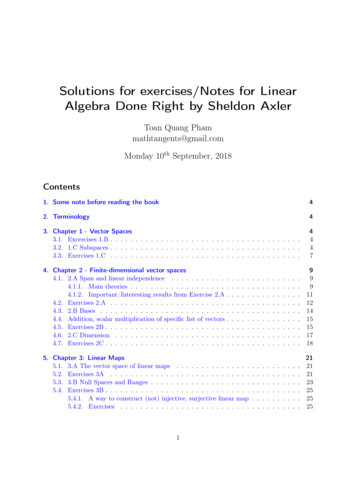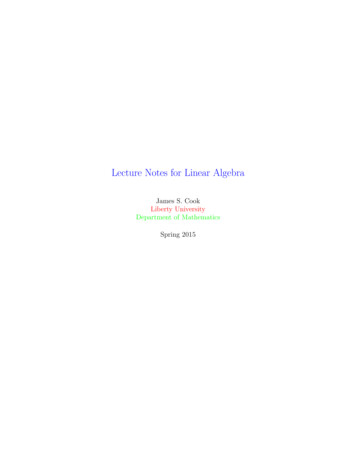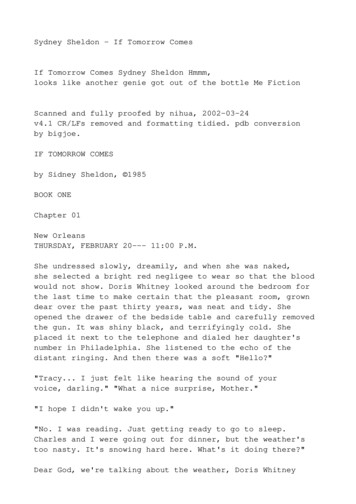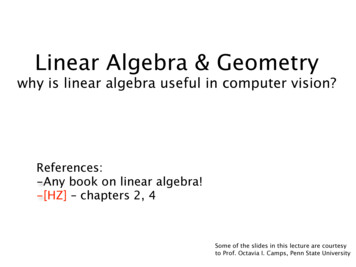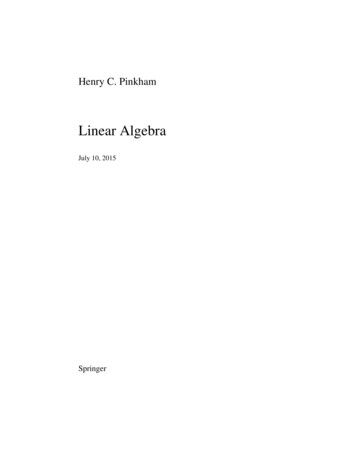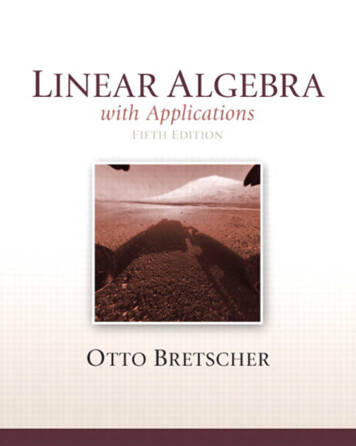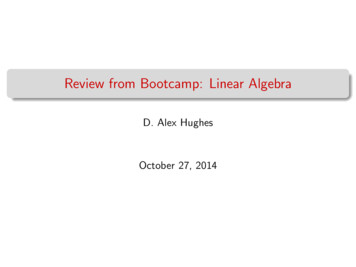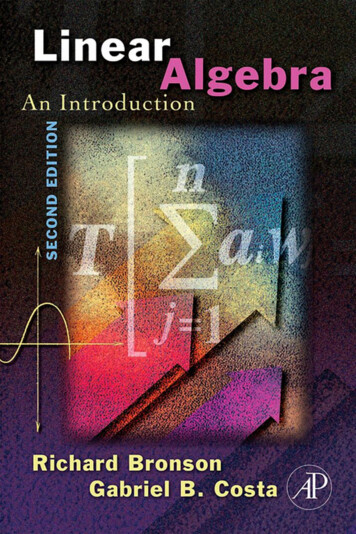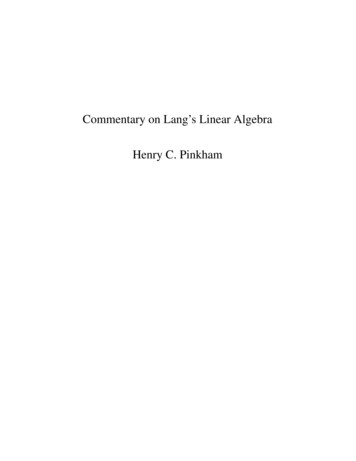
Transcription
Undergraduate Texts in MathematicsSheldon AxlerLinear AlgebraDone RightThird Edition
Undergraduate Texts in Mathematics
Undergraduate Texts in MathematicsSeries Editors:Sheldon AxlerSan Francisco State University, San Francisco, CA, USAKenneth RibetUniversity of California, Berkeley, CA, USAAdvisory Board:Colin Adams, Williams College, Williamstown, MA, USAAlejandro Adem, University of British Columbia, Vancouver, BC, CanadaRuth Charney, Brandeis University, Waltham, MA, USAIrene M. Gamba, The University of Texas at Austin, Austin, TX, USARoger E. Howe, Yale University, New Haven, CT, USADavid Jerison, Massachusetts Institute of Technology, Cambridge, MA, USAJeffrey C. Lagarias, University of Michigan, Ann Arbor, MI, USAJill Pipher, Brown University, Providence, RI, USAFadil Santosa, University of Minnesota, Minneapolis, MN, USAAmie Wilkinson, University of Chicago, Chicago, IL, USAUndergraduate Texts in Mathematics are generally aimed at third- and fourthyear undergraduate mathematics students at North American universities. Thesetexts strive to provide students and teachers with new perspectives and novelapproaches. The books include motivation that guides the reader to an appreciationof interrelations among different aspects of the subject. They feature examples thatillustrate key concepts as well as exercises that strengthen understanding.For further volumes:http://www.springer.com/series/666
Sheldon AxlerLinear Algebra Done RightThird edition123
Sheldon AxlerDepartment of MathematicsSan Francisco State UniversitySan Francisco, CA, USAISSN 0172-6056ISSN 2197-5604 (electronic)ISBN 978-3-319-11079-0ISBN 978-3-319-11080-6 (eBook)DOI 10.1007/978-3-319-11080-6Springer Cham Heidelberg New York Dordrecht LondonLibrary of Congress Control Number: 2014954079Mathematics Subject Classification (2010): 15-01, 15A03, 15A04, 15A15, 15A18, 15A21c Springer International Publishing 2015 This work is subject to copyright. All rights are reserved by the Publisher, whether the whole or partof the material is concerned, specifically the rights of translation, reprinting, reuse of illustrations,recitation, broadcasting, reproduction on microfilms or in any other physical way, and transmission orinformation storage and retrieval, electronic adaptation, computer software, or by similar or dissimilarmethodology now known or hereafter developed. Exempted from this legal reservation are briefexcerpts in connection with reviews or scholarly analysis or material supplied specifically for thepurpose of being entered and executed on a computer system, for exclusive use by the purchaser ofthe work. Duplication of this publication or parts thereof is permitted only under the provisions of theCopyright Law of the Publisher’s location, in its current version, and permission for use must always beobtained from Springer. Permissions for use may be obtained through RightsLink at the CopyrightClearance Center. Violations are liable to prosecution under the respective Copyright Law.The use of general descriptive names, registered names, trademarks, service marks, etc. in thispublication does not imply, even in the absence of a specific statement, that such names are exemptfrom the relevant protective laws and regulations and therefore free for general use.While the advice and information in this book are believed to be true and accurate at the date ofpublication, neither the authors nor the editors nor the publisher can accept any legal responsibility forany errors or omissions that may be made. The publisher makes no warranty, express or implied, withrespect to the material contained herein.Typeset by the author in LaTeXCover figure: For a statement of Apollonius’s Identity and its connection to linear algebra, see the lastexercise in Section 6.A.Printed on acid-free paperSpringer is part of Springer Science Business Media (www.springer.com)
ContentsPreface for the InstructorPreface for the StudentxixvAcknowledgments xvii1 Vector Spaces11.A Rn and Cn2Complex Numbers 2Lists 5Fn 6Digression on Fields 10Exercises 1.A 111.B Definition of Vector Space12Exercises 1.B 171.C Subspaces18Sums of Subspaces 20Direct Sums 21Exercises 1.C 242 Finite-Dimensional Vector Spaces272.A Span and Linear Independence28Linear Combinations and SpanLinear Independence 32Exercises 2.A 3728v
viContents2.B Bases 39Exercises 2.B 432.C Dimension44Exercises 2.C 483 Linear Maps513.A The Vector Space of Linear Maps52Definition and Examples of Linear Maps 52Algebraic Operations on L.V; W / 55Exercises 3.A 573.B Null Spaces and Ranges 59Null Space and Injectivity 59Range and Surjectivity 61Fundamental Theorem of Linear Maps 63Exercises 3.B 673.C Matrices70Representing a Linear Map by a Matrix 70Addition and Scalar Multiplication of Matrices 72Matrix Multiplication 74Exercises 3.C 783.D Invertibility and Isomorphic Vector Spaces80Invertible Linear Maps 80Isomorphic Vector Spaces 82Linear Maps Thought of as Matrix Multiplication 84Operators 86Exercises 3.D 883.E Products and Quotients of Vector SpacesProducts of Vector Spaces 91Products and Direct Sums 93Quotients of Vector Spaces 94Exercises 3.E 9891
Contents3.F Duality 101The Dual Space and the Dual Map 101The Null Space and Range of the Dual of a Linear Map 104The Matrix of the Dual of a Linear Map 109The Rank of a Matrix 111Exercises 3.F 1134 Polynomials117Complex Conjugate and Absolute Value 118Uniqueness of Coefficients for Polynomials 120The Division Algorithm for Polynomials 121Zeros of Polynomials 122Factorization of Polynomials over C 123Factorization of Polynomials over R 126Exercises 4 1295 Eigenvalues, Eigenvectors, and Invariant Subspaces1315.A Invariant Subspaces 132Eigenvalues and Eigenvectors 133Restriction and Quotient Operators 137Exercises 5.A 1385.B Eigenvectors and Upper-Triangular MatricesPolynomials Applied to Operators 143Existence of Eigenvalues 145Upper-Triangular Matrices 146Exercises 5.B 1535.C Eigenspaces and Diagonal MatricesExercises 5.C 1606 Inner Product Spaces1636.A Inner Products and NormsInner Products 164Norms 168Exercises 6.A 175164155143vii
viiiContents6.B Orthonormal Bases180Linear Functionals on Inner Product Spaces 187Exercises 6.B 1896.C Orthogonal Complements and Minimization Problems193Orthogonal Complements 193Minimization Problems 198Exercises 6.C 2017 Operators on Inner Product Spaces2037.A Self-Adjoint and Normal Operators204Adjoints 204Self-Adjoint Operators 209Normal Operators 212Exercises 7.A 2147.B The Spectral Theorem217The Complex Spectral Theorem 217The Real Spectral Theorem 219Exercises 7.B 2237.C Positive Operators and Isometries225Positive Operators 225Isometries 228Exercises 7.C 2317.D Polar Decomposition and Singular Value DecompositionPolar Decomposition 233Singular Value Decomposition 236Exercises 7.D 2388 Operators on Complex Vector Spaces 2418.A Generalized Eigenvectors and Nilpotent OperatorsNull Spaces of Powers of an Operator 242Generalized Eigenvectors 244Nilpotent Operators 248Exercises 8.A 249242233
Contents8.B Decomposition of an Operator252Description of Operators on Complex Vector Spaces 252Multiplicity of an Eigenvalue 254Block Diagonal Matrices 255Square Roots 258Exercises 8.B 2598.C Characteristic and Minimal Polynomials261The Cayley–Hamilton Theorem 261The Minimal Polynomial 262Exercises 8.C 2678.D Jordan Form270Exercises 8.D 2749 Operators on Real Vector Spaces9.A Complexification275276Complexification of a Vector Space 276Complexification of an Operator 277The Minimal Polynomial of the Complexification 279Eigenvalues of the Complexification 280Characteristic Polynomial of the Complexification 283Exercises 9.A 2859.B Operators on Real Inner Product Spaces287Normal Operators on Real Inner Product Spaces 287Isometries on Real Inner Product Spaces 292Exercises 9.B 29410 Trace and Determinant 29510.A Trace 296Change of Basis 296Trace: A Connection Between Operators and Matrices 299Exercises 10.A 304ix
xContents10.B Determinant307Determinant of an Operator 307Determinant of a Matrix 309The Sign of the Determinant 320Volume 323Exercises 10.B 330Photo Credits 333Symbol IndexIndex337335
Preface for the InstructorYou are about to teach a course that will probably give students their secondexposure to linear algebra. During their first brush with the subject, yourstudents probably worked with Euclidean spaces and matrices. In contrast,this course will emphasize abstract vector spaces and linear maps.The audacious title of this book deserves an explanation. Almost alllinear algebra books use determinants to prove that every linear operator ona finite-dimensional complex vector space has an eigenvalue. Determinantsare difficult, nonintuitive, and often defined without motivation. To prove thetheorem about existence of eigenvalues on complex vector spaces, most booksmust define determinants, prove that a linear map is not invertible if and onlyif its determinant equals 0, and then define the characteristic polynomial. Thistortuous (torturous?) path gives students little feeling for why eigenvaluesexist.In contrast, the simple determinant-free proofs presented here (for example,see 5.21) offer more insight. Once determinants have been banished to theend of the book, a new route opens to the main goal of linear algebra—understanding the structure of linear operators.This book starts at the beginning of the subject, with no prerequisitesother than the usual demand for suitable mathematical maturity. Even if yourstudents have already seen some of the material in the first few chapters, theymay be unaccustomed to working exercises of the type presented here, mostof which require an understanding of proofs.Here is a chapter-by-chapter summary of the highlights of the book: Chapter 1: Vector spaces are defined in this chapter, and their basic properties are developed. Chapter 2: Linear independence, span, basis, and dimension are defined inthis chapter, which presents the basic theory of finite-dimensional vectorspaces.xi
xiiPreface for the Instructor Chapter 3: Linear maps are introduced in this chapter. The key result hereis the Fundamental Theorem of Linear Maps (3.22): if T is a linear mapon V, then dim V D dim null T C dim range T. Quotient spaces and dualityare topics in this chapter at a higher level of abstraction than other partsof the book; these topics can be skipped without running into problemselsewhere in the book. Chapter 4: The part of the theory of polynomials that will be neededto understand linear operators is presented in this chapter. This chaptercontains no linear algebra. It can be covered quickly, especially if yourstudents are already familiar with these results. Chapter 5: The idea of studying a linear operator by restricting it to smallsubspaces leads to eigenvectors in the early part of this chapter. Thehighlight of this chapter is a simple proof that on complex vector spaces,eigenvalues always exist. This result is then used to show that each linearoperator on a complex vector space has an upper-triangular matrix withrespect to some basis. All this is done without defining determinants orcharacteristic polynomials! Chapter 6: Inner product spaces are defined in this chapter, and their basicproperties are developed along with standard tools such as orthonormalbases and the Gram–Schmidt Procedure. This chapter also shows howorthogonal projections can be used to solve certain minimization problems. Chapter 7: The Spectral Theorem, which characterizes the linear operatorsfor which there exists an orthonormal basis consisting of eigenvectors,is the highlight of this chapter. The work in earlier chapters pays offhere with especially simple proofs. This chapter also deals with positiveoperators, isometries, the Polar Decomposition, and the Singular ValueDecomposition. Chapter 8: Minimal polynomials, characteristic polynomials, and generalized eigenvectors are introduced in this chapter. The main achievementof this chapter is the description of a linear operator on a complex vectorspace in terms of its generalized eigenvectors. This description enablesone to prove many of the results usually proved using Jordan Form. Forexample, these tools are used to prove that every invertible linear operatoron a complex vector space has a square root. The chapter concludes with aproof that every linear operator on a complex vector space can be put intoJordan Form.
Preface for the Instructorxiii Chapter 9: Linear operators on real vector spaces occupy center stage inthis chapter. Here the main technique is complexification, which is a naturalextension of an operator on a real vector space to an operator on a complexvector space. Complexification allows our results about complex vectorspaces to be transferred easily to real vector spaces. For example, thistechnique is used to show that every linear operator on a real vector spacehas an invariant subspace of dimension 1 or 2. As another example, weshow that that every linear operator on an odd-dimensional real vector spacehas an eigenvalue. Chapter 10: The trace and determinant (on complex vector spaces) aredefined in this chapter as the sum of the eigenvalues and the product of theeigenvalues, both counting multiplicity. These easy-to-remember definitions would not be possible with the traditional approach to eigenvalues,because the traditional method uses determinants to prove that sufficienteigenvalues exist. The standard theorems about determinants now becomemuch clearer. The Polar Decomposition and the Real Spectral Theorem areused to derive the change of variables formula for multivariable integrals ina fashion that makes the appearance of the determinant there seem natural.This book usually develops linear algebra simultaneously for real andcomplex vector spaces by letting F denote either the real or the complexnumbers. If you and your students prefer to think of F as an arbitrary field,then see the comments at the end of Section 1.A. I prefer avoiding arbitraryfields at this level because they introduce extra abstraction without leadingto any new linear algebra. Also, students are more comfortable thinkingof polynomials as functions instead of the more formal objects needed forpolynomials with coefficients in finite fields. Finally, even if the beginningpart of the theory were developed with arbitrary fields, inner product spaceswould push consideration back to just real and complex vector spaces.You probably cannot cover everything in this book in one semester. Goingthrough the first eight chapters is a good goal for a one-semester course. Ifyou must reach Chapter 10, then consider covering Chapters 4 and 9 in fifteenminutes each, as well as skipping the material on quotient spaces and dualityin Chapter 3.A goal more important than teaching any particular theorem is to develop instudents the ability to understand and manipulate the objects of linear algebra.Mathematics can be learned only by doing. Fortunately, linear algebra hasmany good homework exercises. When teaching this course, during eachclass I usually assign as homework several of the exercises, due the next class.Going over the homework might take up a third or even half of a typical class.
xivPreface for the InstructorMajor changes from the previous edition: This edition contains 561 exercises, including 337 new exercises that werenot in the previous edition. Exercises now appear at the end of each section,rather than at the end of each chapter. Many new examples have been added to illustrate the key ideas of linearalgebra. Beautiful new formatting, including the use of color, creates pages with anunusually pleasant appearance in both print and electronic versions. As avisual aid, definitions are in beige boxes and theorems are in blue boxes (incolor versions of the book). Each theorem now has a descriptive name. New topics covered in the book include product spaces, quotient spaces,and duality. Chapter 9 (Operators on Real Vector Spaces) has been completely rewrittento take advantage of simplifications via complexification. This approachallows for more streamlined presentations in Chapters 5 and 7 becausethose chapters now focus mostly on complex vector spaces. Hundreds of improvements have been made throughout the book. Forexample, the proof of Jordan Form (Section 8.D) has been simplified.Please check the website below for additional information about the book. Imay occasionally write new sections on additional topics. These new sectionswill be posted on the website. Your suggestions, comments, and correctionsare most welcome.Best wishes for teaching a successful linear algebra class!Sheldon AxlerMathematics DepartmentSan Francisco State UniversitySan Francisco, CA 94132, USAwebsite: linear.axler.nete-mail: linear@axler.netTwitter: @AxlerLinear
Preface for the StudentYou are probably about to begin your second exposure to linear algebra. Unlikeyour first brush with the subject, which probably emphasized Euclidean spacesand matrices, this encounter will focus on abstract vector spaces and linearmaps. These terms will be defined later, so don’t worry if you do not knowwhat they mean. This book starts from the beginning of the subject, assumingno knowledge of linear algebra. The key point is that you are about toimmerse yourself in serious mathematics, with an emphasis on attaining adeep understanding of the definitions, theorems, and proofs.You cannot read mathematics the way you read a novel. If you zip through apage in less than an hour, you are probably going too fast. When you encounterthe phrase “as you should verify”, you should indeed do the verification, whichwill usually require some writing on your part. When steps are left out, youneed to supply the missing pieces. You should ponder and internalize eachdefinition. For each theorem, you should seek examples to show why eachhypothesis is necessary. Discussions with other students should help.As a visual aid, definitions are in beige boxes and theorems are in blueboxes (in color versions of the book). Each theorem has a descriptive name.Please check the website below for additional information about the book. Imay occasionally write new sections on additional topics. These new sectionswill be posted on the website. Your suggestions, comments, and correctionsare most welcome.Best wishes for success and enjoyment in learning linear algebra!Sheldon AxlerMathematics DepartmentSan Francisco State UniversitySan Francisco, CA 94132, USAwebsite: linear.axler.nete-mail: linear@axler.netTwitter: @AxlerLinearxv
AcknowledgmentsI owe a huge intellectual debt to the many mathematicians who created linearalgebra over the past two centuries. The results in this book belong to thecommon heritage of mathematics. A special case of a theorem may first havebeen proved in the nineteenth century, then slowly sharpened and improved bymany mathematicians. Bestowing proper credit on all the contributors wouldbe a difficult task that I have not undertaken. In no case should the readerassume that any theorem presented here represents my original contribution.However, in writing this book I tried to think about the best way to present linear algebra and to prove its theorems, without regard to the standard methodsand proofs used in most textbooks.Many people helped make this a better book. The two previous editionsof this book were used as a textbook at about 300 universities and colleges. Ireceived thousands of suggestions and comments from faculty and studentswho used the second edition. I looked carefully at all those suggestions as Iwas working on this edition. At first, I tried keeping track of whose suggestionsI used so that those people could be thanked here. But as changes were madeand then replaced with better suggestions, and as the list grew longer, keepingtrack of the sources of each suggestion became too complicated. And lists areboring to read anyway. Thus in lieu of a long list of people who contributedgood ideas, I will just say how truly grateful I am to everyone who sent mesuggestions and comments. Many many thanks!Special thanks to Ken Ribet and his giant (220 students) linear algebraclass at Berkeley that class-tested a preliminary version of this third editionand that sent me more suggestions and corrections than any other group.Finally, I thank Springer for providing me with help when I needed it andfor allowing me the freedom to make the final decisions about the content andappearance of this book. Special thanks to Elizabeth Loew for her wonderfulwork as editor and David Kramer for unusually skillful copyediting.Sheldon Axlerxvii
CHAPTER1René Descartes explaining hiswork to Queen Christina ofSweden. Vector spaces are ageneralization of thedescription of a plane usingtwo coordinates, as publishedby Descartes in 1637.Vector SpacesLinear algebra is the study of linear maps on finite-dimensional vector spaces.Eventually we will learn what all these terms mean. In this chapter we willdefine vector spaces and discuss their elementary properties.In linear algebra, better theorems and more insight emerge if complexnumbers are investigated along with real numbers. Thus we will begin byintroducing the complex numbers and their basic properties.We will generalize the examples of a plane and ordinary space to Rnand Cn , which we then will generalize to the notion of a vector space. Theelementary properties of a vector space will already seem familiar to you.Then our next topic will be subspaces, which play a role for vector spacesanalogous to the role played by subsets for sets. Finally, we will look at sumsof subspaces (analogous to unions of subsets) and direct sums of subspaces(analogous to unions of disjoint sets).LEARNING OBJECTIVES FOR THIS CHAPTERbasic properties of the complex numbersRn and Cnvector spacessubspacessums and direct sums of subspaces Springer International Publishing 2015S. Axler, Linear Algebra Done Right, Undergraduate Texts in Mathematics,DOI 10.1007/978-3-319-11080-6 11
CHAPTER 1 Vector Spaces21.ARn and CnComplex NumbersYou should already be familiar with basic properties of the set R of realnumbers. Complex numbers were invented so that we can take square roots ofnegative numbers. The idea is to assume we have a square root of 1, denotedi, that obeys the usual rules of arithmetic. Here are the formal definitions:1.1Definitioncomplex numbers A complex number is an ordered pair .a; b/, where a; b 2 R, butwe will write this as a C bi . The set of all complex numbers is denoted by C:C D fa C bi W a; b 2 Rg: Addition and multiplication on C are defined by.a C bi/ C .c C d i / D .a C c/ C .b C d /i;.a C bi /.c C d i / D .ac bd / C .ad C bc/iIhere a; b; c; d 2 R.If a 2 R, we identify a C 0i with the real number a. Thus we can thinkof R as a subset of C. We also usually write 0 C bi as just bi, and we usuallywrite 0 C 1i as just i.Using multiplication as definedThe symboli was first used to depabove,you should verify that i 2 D 1.note 1 by Swiss mathematicianDo not memorize the formula for theLeonhard Euler in 1777.product of two complex numbers; youcan always rederive it by recalling thati 2 D 1 and then using the usual rulesof arithmetic (as given by 1.3).1.2Example Evaluate .2 C 3i /.4 C 5i/.Solution.2 C 3i /.4 C 5i/ D 2 4 C 2 .5i / C .3i / 4 C .3i /.5i /D 8 C 10i C 12i 15D 7 C 22i
SECTION 1.A Rn and Cn1.33Properties of complex arithmeticcommutativity C ˇ D ˇ C and ˇ D ˇ for all ; ˇ 2 C;associativity. Cˇ/C D C.ˇ C / and . ˇ/ D .ˇ / for all ; ˇ; 2 C;identities C 0 D and 1 D for all 2 C;additive inversefor every 2 C, there exists a unique ˇ 2 C such that C ˇ D 0;multiplicative inversefor every 2 C with 0, there exists a unique ˇ 2 C such that ˇ D 1;distributive property . C ˇ/ D C ˇ for all ; ; ˇ 2 C.The properties above are proved using the familiar properties of realnumbers and the definitions of complex addition and multiplication. Thenext example shows how commutativity of complex multiplication is proved.Proofs of the other properties above are left as exercises.1.4ExampleShow that ˇ D ˇ for all ; ˇ; 2 C.Suppose D a C bi and ˇ D c C d i, where a; b; c; d 2 R. Thenthe definition of multiplication of complex numbers shows thatSolution ˇ D .a C bi /.c C d i /D .ac bd / C .ad C bc/iandˇ D .c C d i /.a C bi/D .ca db/ C .cb C da/i:The equations above and the commutativity of multiplication and addition ofreal numbers show that ˇ D ˇ .
CHAPTER 1 Vector Spaces41.5Definition , subtraction, 1 , divisionLet ; ˇ 2 C. Let denote the additive inverse of . Thus is the uniquecomplex number such that C . / D 0: Subtraction on C is defined byˇ D ˇ C . /: For 0, let 1 denote the multiplicative inverse of . Thus 1 is the unique complex number such that .1 / D 1: Division on C is defined byˇ D ˇ.1 /:So that we can conveniently make definitions and prove theorems thatapply to both real and complex numbers, we adopt the following notation:1.6Notation FThroughout this book, F stands for either R or C.Thus if we prove a theorem involvingF, we will know that it holds when F isreplaced with R and when F is replacedwith C.Elements of F are called scalars. The word “scalar”, a fancy word for“number”, is often used when we want to emphasize that an object is a number,as opposed to a vector (vectors will be defined soon).For 2 F and m a positive integer, we define m to denote the product of with itself m times: : m D „ƒ‚ The letter F is used because R andC are examples of what are calledfields.m timesClearlyDintegers m; n. m /n mnand. ˇ/mD m ˇ m for all ; ˇ 2 F and all positive
SECTION 1.A Rn and Cn5ListsBefore defining Rn and Cn , we look at two important examples.Example1.7R2 and R3 The set R2 , which you can think of as a plane, is the set of all orderedpairs of real numbers:R2 D f.x; y/ W x; y 2 Rg: The set R3 , which you can think of as ordinary space, is the set of allordered triples of real numbers:R3 D f.x; y; z/ W x; y; z 2 Rg:To generalize R2 and R3 to higher dimensions, we first need to discuss theconcept of lists.1.8Definitionlist, lengthSuppose n is a nonnegative integer. A list of length n is an orderedcollection of n elements (which might be numbers, other lists, or moreabstract entities) separated by commas and surrounded by parentheses. Alist of length n looks like this:.x1 ; : : : ; xn /:Two lists are equal if and only if they have the same length and the sameelements in the same order.Thus a list of length 2 is an ordered Many mathematicians call a list ofpair, and a list of length 3 is an ordered length n an n-tuple.triple.Sometimes we will use the word list without specifying its length. Remember, however, that by definition each list has a finite length that is anonnegative integer. Thus an object that looks like.x1 ; x2 ; : : : /;which might be said to have infinite length, is not a list.A list of length 0 looks like this: . /. We consider such an object to be alist so that some of our theorems will not have trivial exceptions.Lists differ from sets in two ways: in lists, order matters and repetitionshave meaning; in sets, order and repetitions are irrelevant.
CHAPTER 1 Vector Spaces6Example lists versus sets1.9 The lists .3; 5/ and .5; 3/ are not equal, but the sets f3; 5g and f5; 3g areequal. The lists .4; 4/ and .4; 4; 4/ are not equal (they do not have the samelength), although the sets f4; 4g and f4; 4; 4g both equal the set f4g.FnTo define the higher-dimensional analogues of R2 and R3 , we will simplyreplace R with F (which equals R or C) and replace theFana 2 or 3 with anarbitrary positive integer. Specifically, fix a positive integer n for the rest ofthis section.1.10DefinitionFnFn is the set of all lists of length n of elements of F:Fn D f.x1 ; : : : ; xn / W xj 2 F for j D 1; : : : ; ng:For .x1 ; : : : ; xn / 2 Fn and j 2 f1; : : : ; ng, we say that xj is the j thcoordinate of .x1 ; : : : ; xn /.If F D R and n equals 2 or 3, then this definition of Fn agrees with ourprevious notions of R2 and R3 .1.11ExampleC4 is the set of all lists of four complex numbers:C4 D f.z1 ; z2 ; z3 ; z4 / W z1 ; z2 ; z3 ; z4 2 Cg:For an amusing account of howR3 would be perceived by creatures living in R2 , read Flatland:A Romance of Many Dimensions,by Edwin A. Abbott. This novel,published in 1884, may help youimagine a physical space of four ormore dimensions.If n 4, we cannot visualize Rnas a physical object. Similarly, C1 canbe thought of as a plane, but for n 2,the human brain cannot provide a fullimage of Cn . However, even if n islarge, we can perform algebraic manipulations in Fn as easily as in R2 or R3 .For example, addition in Fn is definedas follows:
SECTION 1.A Rn and Cn1.12Definition7addition in FnAddition in Fn is defined by adding corresponding coordinates:.x1 ; : : : ; xn / C .y1 ; : : : ; yn / D .x1 C y1 ; : : : ; xn C yn /:Often the mathematics of Fn becomes cleaner if we use a single letter todenote a list of n numbers, without explicitly writing the coordinates. Forexample, the result below is stated with x and y in Fn even though the proofrequires the more cumbersome notation of .x1 ; : : : ; xn / and .y1 ; : : : ; yn /.1.13Commutativity of addition in FnIf x; y 2 Fn , then x C y D y C x.ProofSuppose x D .x1 ; : : : ; xn / and y D .y1 ; : : : ; yn /. Thenx C y D .x1 ; : : : ; xn / C .y1 ; : : : ; yn /D .x1 C y1 ; : : : ; xn C yn /D .y1 C x1 ; : : : ; yn C xn /D .y1 ; : : : ; yn / C .x1 ; : : : ; xn /D y C x;where the second and fourth equalities above hold because of the definition ofaddition in Fn and the third equality holds because of the usual commutativityof addition in F.If a single letter is used to denote The symbol means “end of thean element of Fn , then the same letter proof”.with appropriate subscripts is often usedwhen coordinates must be displayed. For example, if x 2 Fn , then letting xequal .x1 ; : : : ; xn / is good notation, as shown in the proof above. Even better,work with just x and avoi
Linear Algebra Done Right Third edition 123. ISSN 0172-6056 ISSN 2197-5604 (electronic) ISBN 978-3-319-11079- ISBN 978-3-319-11080-6 (eBook) DOI 10.1007/978-3-319-11080-6 Springer Cham Heidelberg New York Dordrecht London Library of Congress Control Number: 2014954079
